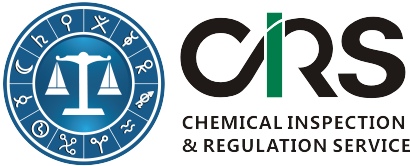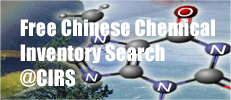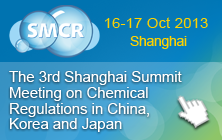Interview With Mr Qiwei Wang from CIRS’s China New Substance Notification Dossier Team
Original Article by CIRS
On 30 August 2012, China MEP released the list of 12 typical notifications of new substances to be approved this year, among which, one high-level typical notification (100-1000t/y) was completed by CIRS. This is a milestone showing the technical breakthrough of CIRS in the notification of new chemical substances in China. The writer of this article has given an interview to Mr Wang Qiwei from CIRS who is in charge of dossier preparation and chemical risk assessment for the new substance, in order to try to help the industry to cope with the problems encountered during the process of dossier preparation and expert technical review. It is expected to shorten the notification period significantly if the notifiers could solve these problems prior to dossier submission.
Q: Could you please give a brief introduction to this substance?
A: The tonnage of this substance is 100-1000t/y, which corresponds to level lll of typical notification in China. It is classified as hazardous according to GHS criteria. The substance name and company name is classified due to the confidentiality agreement.Q: Could you please briefly describe the notification process for us? For example, when did you start this project and how long does this project take to complete?
A: I started this project from October last year and the approval notice was published on MEP’s website at the end of August this year. The whole process has taken approximately 10 months.
I finished collecting and sorting out the test reports and other relevant materials in the middle of January this year. After that I started to prepare the dossier and chemical risk assessment. We finished all notification documents and submitted them to the Chemical Registration Center (CRC) in the middle of February and received the acceptance number two weeks later. The expert group from the MEP then carried out the first technical review of notification dossier and they requested additional materials. After communications with notifier and the quick obtaining of required materials, we submitted the supplementary information to CRC within one week. Two months later we were informed that we successfully passed the second technical review. Finally the MEP released its approval notice in August.
Q: What materials have the expert committee requested during the first technical review?
A: There was no request for additional test data or revised hazardous classification due to the comprehensive test data provided at the beginning of this project. The experts committee only required more detailed environmental exposure information in the chemical risk assessment report.
- The production or technological process. This process should include the contents of hazardous wastes and the description chart of manufacturing process indicating the flow, quantity and material balance data of wastes.
- The detailed disposal measures and effects of wastes and other hazardous chemicals. This additional information shows the importance of chemical risk management and environmental protection in the new chemical registration.
CIRS suggests enterprises to provide real, effective, detailed information of the manufacturing process and disposal of wastes in the new chemical notifications. Relevant chapters should/shall be provided if there is an environmental assessment report. This information helps the experts to assess the exposure risk of new chemicals to the environment and the ability of a company to effectively manage industrial wastes.
Q: Are there any technical innovations during this notification project?
A: We have found some data from public toxicology database and we used this information for the notification according to the guidance document of new chemical notification. This has saved lots of time & costs. It shall be noted that the name of the database, the institute and version number is required when using data from a database.
Q: What are your suggestions for enterprises to shorten notification period?
A: Tests and technical review consume the most time of a notification.
The substance we notified is different from other new chemicals because the enterprise had already obtained most of data, which saved us a lot of test time. Therefore, we would suggest enterprises or exporters to provide any existing full test reports from the likes of REACH registrations for example, which can be used for Chinese new chemical notification, and therefore which could significantly save or reduce the test period. For those eco-toxicological tests which must be carried out in China, we suggest the notifiers to entrust labs with high reputation in quality and efficiency as early as possible.
Environmental exposure concentrations are usually higher through modeling calculations for higher tonnage level substances in Environment Risk Assessment. This requires the enterprises to provide the information of risk control measures during actual manufacturing (or using) processes. This will not only help to finish the risk assessment report, but also to help experts better understand disposal management of the substance, to successfully pass the technical assessment. One or two months could be saved for reducing the number of technical assessments each time.
CIRS suggests the enterprise to have specifically appointed staff member to deal with us during new chemical notifications. This would help us to obtain the necessary materials in time and to solve the problems through effective communication during notification and finally to accelerate the whole process.
Q: What main points does the expert committee focus on?
A: The expert committee, organized by CRC and consisting of experts from fields of toxicology, eco-toxicology and environment protection, etc, usually focuses on classification and risk assessment during the technical review. So it is required that authentic notification materials should be provided with accurate hazard classification, qualitative or quantitative exposure risks assessments and validity of risk control measures.
- We adopt the principle of strict classification, which is that one substance would be classified into hazard of higher level instead of lower level if there is no exact proof indicating the lower level hazard. This requires the strict compliance with a series of national standards of “Safety rules for classification and labeling of chemicals” (GB20576-GB20602) to classify the substance based on existing test data. It is of high importance to have the correct classification. It may take at least 1-2 months for the next technical review if the experts request revision of classification.
- Exposure risks and control measures. Qualitative or quantitative chemical risk assessment should be carried out in Typical Notification. CSR includes the hazard degree to the human and the environment and the effectiveness of risk control measures. These are the key contents for experts review as well as the final approval of notification.
Q: According to your experience in Typical Notification, what is the most difficult obstacle/ part of the process?
A: Technical barriers have already been removed by CIRS and there is no big challenge. Among the 12 Typical Notifications, which were just released in the second list of this year, one high level tonnage notification (100-1000t/y) was accomplished by CIRS. As we know, several other Typical Notifications have already got the approvals from the expert committee and will be released in the near future. The favorable comments from the expert committee regarding our dossier and CSR preparation demonstrate the technical advantages of CIRS. That is because we have a professional team with an abundance of experience and solid techniques to solve the problems encountered during the notification process. This will help other enterprises to accelerate the notification process and gain business advantages on the market.
The difficult points existing in the current notification mainly come from the statements of manufacturing process, exposure risks and management of wastes which are the priority concern of expert committee. Some manufactures have not accomplished the environmental assessments of new chemicals. Some trading companies have not obtained detailed information of manufacturing processes and risk control measurers from downstream users. This leads to the incompleteness of exposure information and risk control measures of new chemicals in the environmental risk assessment. The expert committee always required the notifier to complete this information for further analysis. So, we would like to suggest notifiers to provide as much information as possible about the manufacturing process, the disposal of wastes and risk control measures.
Q: What are the post-notification obligations for notifiers after the approval of new substance notifications?
A: After obtaining a registration certificate, an enterprise can carry out the registered activities like manufacturing or importing, with supervision from local environment protection authorities. The following obligations are required to be fulfilled by notifiers depending on the management category of new substances. .
- Communicate the registration information to downstream users;
- Submit first-activity report;
- Submit the report for each activity of priority hazardous new chemical substances for environmental management;
- Submit the annual report for hazardous new chemical substances (including priority hazardous new chemical substances for environmental management);
- Submit the annual plan and risk control measures for priority hazardous new chemical substances for environmental management;
- Certificate holders should keep documents of notification materials and relevant reports on file for at least 10 years.
A general new substance will be added onto IECSC via MEP’s notice 5 years after the date of submission the first activity report. For hazardous new substances (including priority hazardous new chemical substances for environmental management), registrants shall submit a report on all activities to CRC 6 months prior to the expiration of 5 years. Environment monitoring results or estimation reports shall be included for priority hazardous new chemical substances for environmental management. The MEP will then organize an expert committee to carry out the retrospective assessment and make comments and decide whether to list a new hazardous substance into IECSC according to the comments from the expert committee.
- End-
Find our expert here
Mr Eric Xiong, New Substance Notification in China/Korea/Japan, CIRS China
11/F., Building 1, Dongguan Hi-Tech Park, 1288 Chunbo Road, Binjiang District, Hangzhou 310052, China
Tel: +86-571 8720 6555 | Fax: +86-571 8720 6533
Email: eric.xiong@cirs-reach.com



